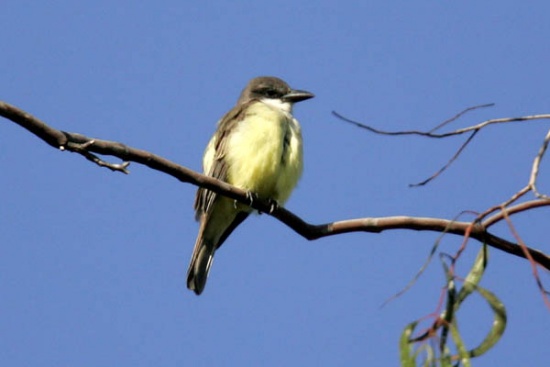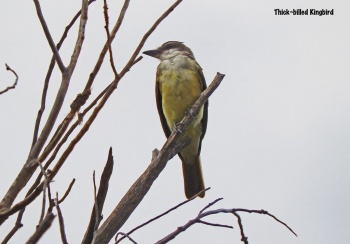m (genus tag, distribution outside US) |
(Bird Song category added) |
||
| (7 intermediate revisions by 4 users not shown) | |||
| Line 1: | Line 1: | ||
| − | [[Image:Thick-billed_Kingbird.jpg|thumb|550px|right|Photo by raulroa<br /> | + | [[Image:Thick-billed_Kingbird.jpg|thumb|550px|right|Photo by {{user|raulroa|raulroa}}<br />Banning Park, Wilmington, [[California]], November 2005]] |
;[[:Category:Tyrannus|Tyrannus]] crassirostris | ;[[:Category:Tyrannus|Tyrannus]] crassirostris | ||
==Identification== | ==Identification== | ||
| − | Greyish-brown upperparts | + | 20·5–24 cm (8-9½ in) |
| − | Juvenile: upperparts browner than adult, underparts brighter yellow than adult | + | *Greyish-brown upperparts |
| + | *Dark grey-brown head | ||
| + | *Blackish mask | ||
| + | *Yellow crown patch | ||
| + | *Large, thick, black bill | ||
| + | *Whitish throat and breast | ||
| + | *Yellowish belly and undertail [[Topography#General Anatomy|coverts]] | ||
| + | *Slightly forked, grey-brown tail with cinnamon-brown edges<br /> | ||
| + | Juvenile: upperparts browner than adult, underparts brighter yellow than adult | ||
| + | [[Image:Kingbird-Thick-billed-Juv-AZ-Pat-DSCN2804 copy 2.jpg|thumb|350px|right|Juvenile<br />Photo by {{user|Brian+Hubbs|Brian Hubbs}}<br />Patagonia, [[Arizona]], August 2016]] | ||
==Distribution== | ==Distribution== | ||
| − | [[ | + | [[North America|North]] and [[Central America]]<br /> |
| + | '''North America''': found in [[Arizona]] and [[New Mexico]]<br /> | ||
| + | '''Central America''': [[Mexico]] <br /> | ||
| + | Winters south to [[Guatemala]]. | ||
==Taxonomy== | ==Taxonomy== | ||
| + | ====Subspecies==== | ||
| + | *''T. c. pompalis'': | ||
| + | :*Extreme south-eastern [[Arizona]] south along west coast of [[Mexico]] to Colima | ||
| + | *''T. c. crassirostris'': | ||
| + | :*South West Mexico (Guerrero to Oaxaca); winters to [[Guatemala]] | ||
==Habitat== | ==Habitat== | ||
Streamside growth, sycamore canyons. | Streamside growth, sycamore canyons. | ||
==Behaviour== | ==Behaviour== | ||
| − | The diet | + | ====Diet==== |
| − | + | The diet has been poorly recorded. They are believed to be primarily inectivorous, with the addition of seeds berries and fruit at times as well. | |
| − | + | ====Breeding==== | |
| − | + | The cup shaped nest is constructed from twigs, grass, and plant stems. It is built in a sycamore or cottonwood tree. The clutch consists of 3-4 brown spotted white eggs which are incubated by the female for 18-20 days. | |
| − | The cup shaped nest is | ||
| − | 3-4 white eggs | ||
| − | |||
| + | ====Vocalisation==== | ||
| + | {{ Audio|MVI 0789 02.mp3}} <br />Voice recording by {{user|jmorlan|Joseph Morlan}}<br />Flood Park, Menlo Park, [[California]], [[USA]], 30 October 2021. | ||
| + | ==References== | ||
| + | #{{Ref-Clements6thAug16}}#Avibase | ||
| + | #Handbook of the Birds of the World Alive (retrieved September 2016) | ||
| + | #Whatbird | ||
| + | {{ref}} | ||
==External Links== | ==External Links== | ||
{{GSearch|Tyrannus+crassirostris}} | {{GSearch|Tyrannus+crassirostris}} | ||
| − | [[Category:Birds]][[Category:Tyrannus]][[ | + | [[Category:Birds]][[Category:Tyrannus]] [[Category:Bird Songs]] |
Latest revision as of 21:56, 31 October 2021
- Tyrannus crassirostris
Identification
20·5–24 cm (8-9½ in)
- Greyish-brown upperparts
- Dark grey-brown head
- Blackish mask
- Yellow crown patch
- Large, thick, black bill
- Whitish throat and breast
- Yellowish belly and undertail coverts
- Slightly forked, grey-brown tail with cinnamon-brown edges
Juvenile: upperparts browner than adult, underparts brighter yellow than adult
Distribution
North and Central America
North America: found in Arizona and New Mexico
Central America: Mexico
Winters south to Guatemala.
Taxonomy
Subspecies
- T. c. pompalis:
- T. c. crassirostris:
- South West Mexico (Guerrero to Oaxaca); winters to Guatemala
Habitat
Streamside growth, sycamore canyons.
Behaviour
Diet
The diet has been poorly recorded. They are believed to be primarily inectivorous, with the addition of seeds berries and fruit at times as well.
Breeding
The cup shaped nest is constructed from twigs, grass, and plant stems. It is built in a sycamore or cottonwood tree. The clutch consists of 3-4 brown spotted white eggs which are incubated by the female for 18-20 days.
Vocalisation
Voice recording by Joseph Morlan
Flood Park, Menlo Park, California, USA, 30 October 2021.
References
- Clements, J. F., T. S. Schulenberg, M. J. Iliff, D. Roberson, T. A. Fredericks, B. L. Sullivan, and C. L. Wood. 2016. The eBird/Clements checklist of birds of the world: v2016, with updates to August 2016. Downloaded from http://www.birds.cornell.edu/clementschecklist/download/
- Avibase
- Handbook of the Birds of the World Alive (retrieved September 2016)
- Whatbird
Recommended Citation
- BirdForum Opus contributors. (2024) Thick-billed Kingbird. In: BirdForum, the forum for wild birds and birding. Retrieved 9 May 2024 from https://www.birdforum.net/opus/Thick-billed_Kingbird





